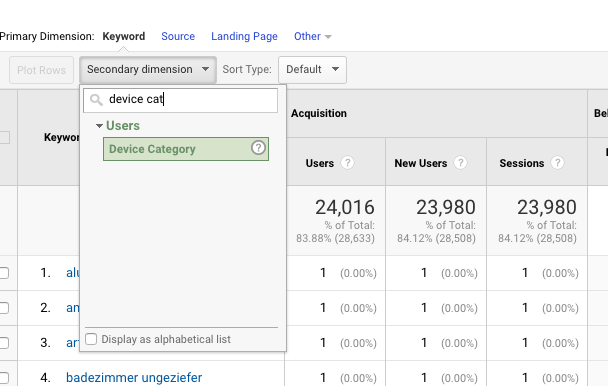Unlock Deeper Insights With Additional Dimension in Google Analytics
With the large area of information offered in Google Analytics, the usage of second measurements can considerably improve your logical abilities. These added layers of information provide a nuanced viewpoint that can illuminate intricate details within your key metrics. By tactically incorporating second dimensions right into your analysis, you can uncover important understandings that may or else stay obscure. The ability to divide and interpret user behavior with higher accuracy opens a realm of opportunities for optimizing methods and improving performance.
Comprehending Main Vs. Second Dimensions
When evaluating data in Google Analytics, it is crucial to compare secondary and main measurements to obtain much deeper understandings right into user actions. Primary dimensions are the primary classifications through which you can watch your information, such as tool, landing, or source/medium web page. These dimensions supply the essential structure for organizing and understanding your information. On the other hand, secondary measurements enable you to more explore your primary measurement information. By adding a second dimension, you can layer on additional details to your main dimension, enabling a more granular analysis. If your main measurement is the source/medium with which customers got here on your website, adding a secondary dimension like geographic location can disclose where those users are located geographically. This included layer of info can help you determine trends, patterns, or anomalies that may not have actually appeared when looking at the main measurement alone. Leveraging both main and secondary measurements in Google Analytics is important for detailed information analysis and notified decision-making.
Using Secondary Dimensions Properly
By integrating additional measurements along with main dimensions, marketing experts and experts can delve deeper into the specifics of individual interactions on their internet sites. Additional measurements enable customers to sector and filter key dimension data further, supplying a much more detailed sight of user demographics, interactions, and habits.
Additionally, second measurements make it possible for individuals to compare and contrast various information points within a solitary record, assisting in an extra detailed evaluation of user habits patterns. By leveraging additional measurements successfully, organizations can discover hidden understandings, optimize their advertising and marketing methods, and boost the overall individual experience on their websites.
Checking Out Usual Second Dimension Mixes
To better analyze user actions and patterns in Google Analytics, it is valuable to check out usual combinations of additional dimensions. Some typical second measurement combinations that give valuable understandings include evaluating traffic sources with customer locations to comprehend where internet site visitors are coming from geographically and how they found the website. Taking a look at individual habits metrics with secondary measurements such as demographics or passions can help in targeting particular target market segments a lot more properly.
Using Second Measurement in Custom-made Information
Utilizing additional measurements in personalized reports enables for a more detailed evaluation of information in Google Analytics, boosting the deepness of understandings acquired. When producing customized records in Google Analytics, including additional measurements can give a more comprehensive sight of exactly how numerous measurements engage with each other. This feature allows individuals to delve deeper right into their information and uncover valuable correlations that might not be quickly noticeable.
By using additional measurements in custom reports, customers can gain a better understanding of their web site or application traffic. For instance, incorporating the key measurement of "source/medium" with the additional dimension of "touchdown page" can expose which landing pages are doing best for traffic coming from details sources. This insight can help marketing professionals maximize their projects and boost total conversion prices.

Enhancing Information Visualization With Second Dimension
When checking out data in Google Analytics personalized reports, incorporating additional measurements not just offers a more in-depth evaluation yet additionally enhances the visual depiction of insights through data visualization. By adding a second measurement to your records, you can enrich the way information exists, making it check it out much easier to recognize patterns, trends, and relationships within your web site's efficiency metrics.
Second dimensions can aid you section your data additionally, enabling a much deeper understanding of customer habits and communications on your site. When attempting to separate specific variables that might affect your site's performance., this improved level of granularity can be particularly helpful.

Conclusion
Finally, leveraging secondary measurements in Google Analytics permits a more thorough analysis of information, resulting in much deeper insights and even more enlightened decision-making. Secondary Dimension in Google Analytics. By adding added layers of info to key data collections, marketers and analysts can uncover surprise trends, patterns, and correlations that provide a granular why not try here sight of individual actions and interactions. This boosted level of understanding makes it possible for optimization of campaigns and customized techniques for certain target market segments, ultimately enhancing efficiency and conversion prices
On the other hand, second measurements allow you to more study your primary measurement data. By adding an additional measurement, you can layer on additional info to your main measurement, enabling a more granular analysis. If your main measurement is the source/medium via which users showed up on your website, adding a second measurement like geographical location can reveal where those individuals are located geographically. By integrating secondary dimensions along with primary measurements, analysts and marketers can delve deeper into the specifics of user interactions on their websites. Secondary dimensions allow users to sector and filter main dimension data further, using a much more comprehensive sight of user habits, interactions, and demographics.
Comments on “Exactly How to Use Secondary Dimension in Google Analytics for Deeper Insights”